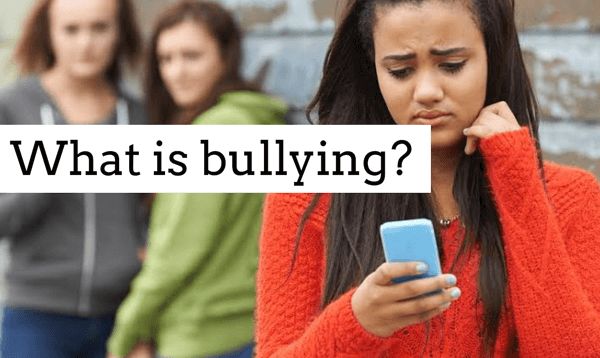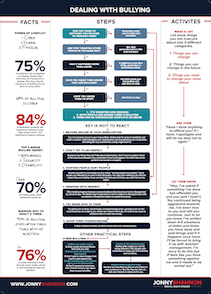What is Bullying? The 7 Different Types (2024)
It isn't always punches and name-calling.
Today, bullying can take many forms and happen across a variety of platforms.
As a parent or a teacher, are you aware of the many different ways that bullying can manifest itself? Knowing the signs, the precursors and the right steps to take can help mitigate or prevent it, but it all starts with being informed.
Today, we're answering a common question in a more in-depth way. What is bullying? More specifically, what does it look like in the 21st century and how can concerned guardians and educators be as proactive as possible in the quest to end it? Join us as we explore the facts and share insights for a brighter and safer future!
What is Bullying?
“Bullying is ongoing misuse of power in relationships through repeated verbal, physical and/or social behaviour that causes physical and/or psychological harm. It can involve an individual or a group misusing their power over one or more persons. Bullying can happen in person or online, and it can be obvious (overt) or hidden (covert).” - Bullying Definition
However, like any standard and traditional concept, it's morphed over the years. As a society, we've entered an era in which there are now more mediums than ever before through which bullying can occur. This means the stereotypical rough-and-tumble playground spats that might have defined bullying decades ago are no longer the trademark signs.
More more info on Why do kids bully - check out my new article.
What are the Different Types of Bullying?
Pushing and shoving isn't the end-all, be-all type of bullying that people of all ages participate in. In fact, there are six main categories of bullying that define different techniques and methods used to intimidate someone. Let's take a look at bullying behaviours;
Physical
Verbal
Cyber
Emotional
Prejudicial
Sexual
What Can we Do about it?
1. Physical Bullying
The most obvious and apparent form of bullying, physical bullying is what most people think of when they consider this concept. This occurs when people use their physical force and actions to take control of someone else. Though it isn't always the case, physical bullies are often bigger, stronger and more fit than their peers. Knowing this, they use their strength and power to their advantage, using their body to weaken their target.Some of the physical attacks inflicted during physical bullying include:
Kicking
Punching
Hitting
Shoving
Slapping
Slamming
While some forms of bullying can be more difficult to discern or identify, physical bullying tends to manifest itself in visible wounds and abrasions. However, teachers should keep in mind that many wounds can be strategically inflicted to be covered up my clothing or makeup. As such, it's important to look for other signs that a schoolchild is being bullied, such as emotional trauma.
2. Verbal Bullying
Name-calling might be a centuries-old way to hurt and embarrass someone, but it doesn't mean it's gotten any less painful over the years.
From children who get picked on at recess to spouses who are repeatedly lashed out at by their partner, verbal bullying can take many forms. Unlike physical bullies who use their bodies to inflict harm, verbal bullies use words, language, and painful statements to bring a similar level of shame.
Most of these perpetrators will choose targets who are weaker or impaired and hurl insults at them to belittle them. For instance, it's not uncommon for verbal bullies to pick on students with special needs who cannot defend themselves or share a biting comment back.
This kind of bullying can be difficult to identify, especially for teachers. This is because most verbal assaults take place in private, when adults aren't around. This often leads to a case of he-said, she-said where it's one person's word against another.
In addition, because there is no physical harm inflicted, some adults might tell kids to "get over it" or "ignore it." However, this is an unhealthy way to deal with a very real and very troubling issue.
Verbal bullying can leave permanent internal wounds that impair a target for life. In addition, many bullies who use their words to harm others also use their bodies, so physical and verbal bullying often go hand-in-hand.
3. Cyberbullying
It's no secret that we're raising a generation of children who are more tech-savvy and connected than ever before. In fact, industry research shows that nine in 10 Aussie teenagers now have at least one mobile device.
Thanks to chat groups, social media, and other online forums, students can communicate and collaborate with each other in real-time. Unfortunately, it's all too easy for cyberbullies to hide behind the protection of a screen. When they don't have to face their target in person, they're more comfortable using words or actions that they might not use in real life.
Cyberbullying occurs when someone uses the internet to share hurtful comments, slander, embarrass, threaten, harass or otherwise harm someone else. If the event takes place with an adult present, the term changes to cyber-harassment. It can also be called cyberstalking.
Though the issue is wide and varied, there are some activities that have become the trademark of cyberbullies.
A few examples include:
Posting hurtful comments
Sharing hurtful or embarrassing images
Making threats online
Sending hurtful emails or text messages
The more that teens and tweens are plugged in, the bigger of an issue this will become. Like verbal bullying, cyberbullying can leave long-lasting scars of hurt and shame. It's also almost impossible to escape this form of harassment, as those with smart devices are almost always attached to them.
4. Emotional Bullying
Also called relational aggression, emotional bullying often goes unnoticed by unassuming parents and teachers alike. That's because it can be difficult to identify, but it's present everywhere you look.
In short, emotional bullying occurs when students try to ostracise one of their peers by changing their social standing, putting themselves in a more powerful and popular position in the process. Any parent whose child has ever come home from school upset and feeling left out, claiming that they're no longer a part of their former social circle, has felt the brunt of this kind of attack.
This is a very calculated type of social manipulation that can leave targets feeling isolated and alone.
The ways that an emotional bully might achieve his or her aim include:
Spreading lies about the target
Sharing secrets told in confidence
Exposing embarrassing aspects of the target's life
Manipulating social situations
Breaking trust
As a result of these actions, a child on the receiving end of this situation will often feel insulted, teased, ganged up against, excluded or ignored. In some cases, this isolation can trigger a retaliation that leads to a vicious cycle of ongoing bullying.
For the most part, this kind of bullying is more present in female social groups than male ones, although this doesn't apply to every situation. However, it helps shed light on some of the most popular terms in this age group's vernacular: mean girls and frenemies.
5. Prejudicial Bullying
Any time that someone is bullied because of his or her race, religion, or sexual orientation, this is prejudicial bullying or racism bullying. It's called this because the root of the attack is the bully's preconceived prejudices against the other person or persons.
While this might be where it all begins, prejudicial bullying is rarely an isolated event. Usually, it escalates into physical bullying, verbal bullying, or cyberbullying.
Anyone who targets someone who looks or acts differently than they do is a prejudicial bully. Though it can seem insignificant at first, this is arguably the most serious form of bullying, as it can open the door to much more serious events, such as hate crimes. That's why it's critical to take every instance seriously.
6. Sexual Bullying
There are many different forms that sexual bullying could take. In addition to physically harming someone in a sexual manner, it can also include any verbal or emotional attacks that seek to humiliate or shame them sexually.
From name-calling and crude remarks to obscene gestures and uninvited exposure or touching, there are myriad actions categorised under this umbrella. When such comments about a target's appearance or sexual development turn physical, the issue turns from sexual bullying into sexual assault.
This kind of bullying most often targets girls, though boys can be targets, too. And, it's important to keep in mind that the attacks don't only happen between people of opposing genders. It's common for girls to sexually bully other girls, shaming them with hurtful labels that expose or insinuate their promiscuity.
Sometimes, cyberbullying and sexual bullying occur at the same time. For instance, two parties could engage in sexting while in a relationship. Then, when they break up, one party shares the personal and humiliating messages with a larger crowd. In response, peers begin sexually bullying that person, calling them names and hurling insults in their direction.
What Can Teachers Do?
As a parent or student I list 3 strategies to practice on another blog on bullying I think are useful. As a teacher, you naturally want the best for your students. You want them to come to school and feel safe, protected and like a valuable part of society.
That said, what can you do to help prevent bullying in your classroom?
The answer lies in taking prompt action and speaking up as soon as you notice any signs of any form of bullying. Reporting the instance to the proper school authorities can help the targets receive prompt and professional help. More Great advice for parents and teachers here at commonsense media.
However, it's best to work toward a proactive approach to bullying, not a reactive one.
One of the most powerful and influential steps you can take as an educator is to help prevent bullying from ever happening. This is made possible through programs and activities that teach students about bullying.
From student presentations and group discussions to creative writing exercises and art projects, there are many ways you can teach anti-bullying concepts and get your classroom as involved as possible.
1. Bullying Policies
Having a policy for your school in place is a must have. You students, teachers and parents should all know where school stands with bullying and the consciences to the parties involved when it does happen. If you would like an example of a school policy email me or comment below and I have send you some.
A good way is to release these new additions to your Bullying Presentation around National Bullying Prevention Month (October).
2. Bullying Course
There are some great courses out there on bullying. Brooks Gibbs from the USA did an amazing course i went through. Another more recent example is Tom Thelen who also provides online material for entire schools. This is great for American schools.
If you based in New Zealand or Australia I've partnered with Archy Learning to create a free online course around bullying among other issues as well. Will be available at cybersafe.com.au in late 2024.
3. Organise a Anti-Bullying Speaker
However, one of the most powerful ways to get the message across is to hire a professional youth speaker to share the same sentiment. Let's take a look at a few reasons why this step is so effective.
It's Relatable
Youth speakers who focus on the concept of bullying often have a life story that's shaped their direction in life. Take Jonny, for instance. Years of undiagnosed dyslexia and other disabilities led to him being bullied by his peers, which led to fighting back and expulsions from school. Yet, thanks to the advice and guidance of a school counselor, he turned his situation around.
Now, he's one of the most sought-after speakers in all of Australia, teaching children of all ages how to -- you guessed it -- stop the painful chain of school bullying.
It's Influential
When well-meaning parents or teachers harp that bullying is wrong, it can often fall on deaf ears. Yet, when someone of authority and power takes the stage, the same message is suddenly more impactful. A professional youth speaker will command the stage and speak with confidence, encouraging everyone in the room to listen up and take notes.
It's Inspiring
There are likely children in your school who are currently hiding the signs that they're being bullied.
They might put on a brave face in the classroom but are crumbling inside from years of shame and humiliation. Seeing someone who has been in their same shoes and risen from the pain can be an important turning point in their lives. Investing in a presentation from a professional public speaker can give them hope, as well as the courage to take action to stop the situation in their own lives.
Spread a Powerful Anti-Bullying Message at Your School
Do you want to give your students the gift of empowerment? Have they started asking important questions, such as "What is bullying?" In addition to implementing anti-bullying lessons in your classroom, talking openly about the concept and taking swift action if you ever suspect it occurring, you can take the movement one step further.
When you hire a professional youth speaker to come to speak at your school, you're directly investing in the future of your student population. Interested in hearing my message? Check availability and request a booking today :)
Thank you for reading and as always if you have any comments or questions please send it in below.
- Jonny Shannon



